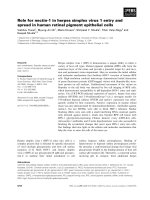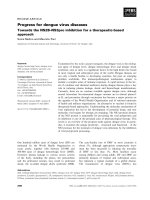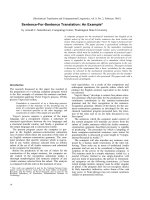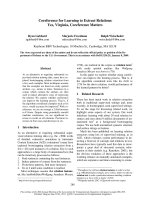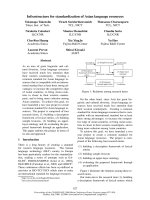Báo cáo khoa học: "Radiosurgery for pituitary adenomas: evaluation of its efficacy and safety" ppsx
Bạn đang xem bản rút gọn của tài liệu. Xem và tải ngay bản đầy đủ của tài liệu tại đây (234.69 KB, 6 trang )
RESEARC H Open Access
Radiosurgery for pituitary adenomas: evaluation
of its efficacy and safety
Douglas G Castro
*
, Soraya AJ Cecílio, Miguel M Canteras
Abstract
Object: To assess the effects of radiosurgery (RS) on the radiological and hormonal control and its toxicity in the
treatment of pituitary adenomas.
Methods: Retrospective analysis of 42 patients out of the first 48 con secutive patients with pituitary adenomas
treated with RS between 1999 and 2008 with a 6 months minimum follow-u p. RS was delivered with Gamma Knife
as a primary or adjuvant treatment. There were 14 patients with non-secretory adenomas and, among functioning
adenomas, 9 were prolactinomas, 9 were adrenocorticotropic hormone-secreting and 10 were growth hormone-
secreting tumors. Hormonal control was defined as hormonal response (decline of more than 50% from the pre-RS
levels) and hormonal normalization. Radiological control was defined as stasis or shrinkage of the tumor.
Hypopituitarism and visual deficit were the morbidity outcomes. Hypopituitarism was defined as the initiation of
any hormone replacement therapy and visual deficit as loss of visual acuity or visual field after RS.
Results: The median follow-up was 42 months (6-109 months). The median dose was 12,5 Gy (9 - 15 Gy) and 20
Gy (12 - 28 Gy) for non-secretory and secretory adenomas, respectively. Tumor growth was controlled in 98% (41
in 42) of the cases and tumor shrinkage ocurred in 10% (4 in 42) of the cases. The 3-year actuarial rate of
hormonal control and normalization were 62,4% and 37,6%, respectively, and the 5-year actuarial rate were 81,2%
and 55,4%, respectively. The median latency period for hormonal control and normalization was, respectively, 15
and 18 months. On univariate analysis, there were no relationships between me dian dose or tumoral volume and
hormonal control or normalization. There were no patients with visual deficit and 1 patient had hypopituitarism
after RS.
Conclusions: RS is an effective and safe therapeutic option in the management of selected patients with pituitary
adenomas. The short latency of the radiation response, the highly acceptable radiological and hormonal control
and absence of complications at this early follow-up are consistent with literature.
Introduction
Pituitary adenomas represent nearl y 15% of all intracr a-
nial tumors and are associated with significant morbidity
due to either local compressive effects and/or hormonal
hypersecretion [1]. Their clinical classification into non-
functioning or functioning tumors is defined on the
basis of hormonal serum level. Surgery, radiotherapy
and medication are the three key elements of t he treat-
ment strategy [2]. Transsphenoidal microsurgery has
remained the primary treatment for most patients with
non-functioning pituitary microadenomas or functioning
microadenomas causing acromegaly or Cushing’ s
disease. Most prolactinomas can be controlled succes-
fully by medical treatment and transsphenoidal micro-
surgery is the second treatment step [3].
The persistence or recurrence of disease due to tumor
invasion into surrounding st ructures or incomplete
tumor resection is quite common and long term tumor
control rates after t ranssphenoidal excision alone vary
from 50 to 80% [4]. For residual or recurrent tumors
fractionated radiation therapy has been the traditional
treatment. However, it has a prolonged latency up to
one decade for its effects and is associated with more
frequent side effe cts as hypopituitarism, visual damage
and cerebral vasculopathy [2,5].
Recently, radiosurgery (RS) has gained acceptance as a
complementary treatment option in combination with
* Correspondence:
Institute of Neurological Radiosurgery (IRCN), Alvorada street, 64, suit 13/14,
São Paulo-SP, ZIP: 04550-000, Brazil
Castro et al. Radiation Oncology 2010, 5:109
/>© 2010 Castro et al; licensee BioMed Central Ltd. This is an Open Access article distributed under the terms of the Creative Commons
Attribution License ( w hich permits unrestricted use, distribution, and reproduction in
any medium, provided the original work is properly cited.
microsurgery. RS provides growth control and long-term
endocrine control that is superior to that of repeat
resective surgery and the latency of the radiation
response is substantially shorter than that of fractio-
nated radiotherapy. Besides that, as RS better limits
radiation exposure of the surrounding normal brain, it
has been associated with a significantly lower morbidity
than conventional fractionated radiotherapy [5-8].
This investigation was conducted to ev aluate the
effects of Gamma Knife RS on the growth and endocri-
nological response and its safety in the treatment of
pituitary adenomas.
Materials and methods
Patient population
Forty-two out of the first 48 consecutive patients with
pituitary adenoma were treated with RS at the Institute
of Neurological Radiosurgery between 1999 and 2008,
with a 6 months minimum follow-up.
Radiosurgery was delivered as a primary or adjuvant
treatment. There were 14 patients with non-secretory
adenomas (NSA) and, among functioning adenomas, 9
were prolactinomas (PRL), 9 were adrenocorticotropic
(ACTH) and 10 were growth hormone-secreting tumors
(GH).
All study patients met the eligibility criteria: histologi-
cal or radiological diagnosis of pituitary adenoma and a
minimum 3 mm distance between the tumor and optic
apparatus. In patients selected for RS, clinical, laborator-
ial and radiological evaluation were performed. Clinical
evaluation consisted of neurological examination and a
comprehensive ophthalmological evaluation including
visual field tests. Laboratorial and radiological evaluation
included hormonal level assessment and magnetic reso-
nance imaging (MRI).
Treatment
RS was performed using the Leksell gamma unit model
B (Elekta Instruments; Atlanta, GA, USA) with 201
60
Co
sources.
Images for target definition and dose planning were
obtained from both MRI and computerized tomography
scanning (CT). The MRI studies were T1-weighted 1
mm axial and coronal gadolinium-enhanced slices and
T2-weighted 1 mm coronal slices. The CT images con-
sisted of a series of contrasted-enhanced 1 mm slices.
The images were exported to GammaPlan V2.01 (Elekta
Instruments; Atlanta, GA,USA)fordoseplanning.
Microadenomas usually appear as hypointense lesions
on T1-weighted MRI. The gadolinium contrast to adja-
cent normal gland enhances and highlights the injury.
Macroadenomas are usually isointense on T1 and
enhance homogeneously, but more slowly than normal
tissue. Dose selection was limited by the tolerance of
the adjacent structures. The maximum dose applied to
the optic nerves and chiasm was most frequently 8 Gy
and was rarely as high as 9 Gy. Functioning tumors
received the highest possible marginal dose, as higher
marginal dose are associated with a higher rate of hor-
monal normalization. A minimum marginal dose of 12
Gy was generally considered for non-functioning
tumors.
Therapeutic evaluation criteria and follow-up
We defined hormonal control (HC) as the junction of
hormonal normalization (HN) and hormonal response
(HR). The latter was defined as a decline in the mea-
sured hormonal level of more than 50% from the pre-RS
hormonal levels. In order to define HN, in A CTH-
secreting tumors, w e used the dosage of ACTH serum
as a parameter. In GH-secreting, we evaluated the basal
GH and IGF-1 and appropriate sex and age, in prolacti-
nomas, we consider the level of serum p rolactin and
appropriate sex. Radiological control (RC) was defined
as the junction of radiological stasis (RSt) and radiologi-
cal response (RR). RSt wa s defined as a tumor enlarge-
ment or shrinkage of less than 20% and RR as a tumor
shrinkage of more than 20%.
Pituitary deficiency was defined as a requirement for
new hormonal replacement medication after RS or a
requirement for a dose increase in preexisti ng hormone
therapy. Visual deficit due to RS was regarded if the
patient reported post-RS visual complaints related to
damage to the perisellar optic apparatus confirmed by
visual field and acuity examinations.
The follow-up schedule included clinical examinations
with ophthalmological and endocrinological evaluations
and MRI of the brain and sellar region at 6-month
intervals for the first 24 months after treatment and
annually thereafter.
Statistical analysis
All statistical analyses were performed with a statistical
software package (SPSS version 13.0; SPSS Inc; Chicago,
IL, USA). Cumulative rates for HC and HN were calcu-
lated using the Kaplan-Meier method. Univariate anal y-
sis was assessed using the log-rank-test. Differences
were considered statistically significant at p < 0.05.
Results
Patient characteristics
The median follow-up period was 42 months (6-109
months). The median patient age at the time of the pro-
cedure was 43 years (range 16-78 years). There were 20
men (48%) and 22 women (52%). Most patients were
treated for residual (76%) or recurrent tumors (17%)
after surgery, medication or radiotherapy, whereas only
3 patients (2 patients with prolactinomas and 1 patient
Castro et al. Radiation Oncology 2010, 5:109
/>Page 2 of 6
with non-functioning adenoma) had RS as a primary
treatment (7%). Before RS, surgery alone was done in
22 patients, medication alone in 5 and both treatments
in 12 patients. Only 2 patients were treated with surgery
followed by external beam radiotherapy (EBRT). Before
RS, 17 patients used medication while 13 patients used
it after RS.
Treatment characteristics
The median target volume was 1.3 cm
3
(rang e 0.03-11.1
cm
3
). Multiple isocenters ranging from 1 to 16 in num-
ber (median 7) were used, resulting in the median con-
formity index of 0.89 (range 0.42-1.7). The tumor
margin was covered by an isodose ranging from 20 to
60% (median 50%). The median dose was 12.5 Gy (9-15
Gy) and 20 Gy (12-28 Gy) for non-secretory and secre-
tory adenomas, respectively. The median maximum
dose to the optic chiasm was 3.7 Gy (0.1-8 Gy). and to
the optic nerve was 3.4 Gy (0.2-7.6 Gy).
Radiological evaluation
Tumor volume was assessed from the follow-up MRIs in
42 cases. RC was achieved in 41 ( 98%) cases (Table 1).
Only one patient develo ped local tumor enlargement of
more than 20% and, later, distant encephalic progres-
sion. This patient had an ACTH tumor that had failed
after transsphenoidal, transcranial surgery, medication
and EBRT. After RS, he was treated with adren alectomy
and developed Nelson’s syndrome. He also underwent
transcranial surgery that revealed pituitary carcinoma.
This patient died 3 years after RS.
Hormonal evaluation
Twenty-eight patients had functioning pituitary adenoma.
HCwasachievedin22(78%)cases.HNandHRwere
observed in 14 (50%) and 8 (28%) cases, respectively.
Hormonal progression occurred in 1 case (Table 2).
The median pre and post-radiosurgical ACTH levels
were, respectively, 102 and 47 pg/ml; the median pre
and post-radiosurgical GH and IGF-1 levels were,
respectively, 5.8 and 2.9 ng/ml and 688.5 and 361.5 ng/
ml; the median pre- and post-radiosurgircal prolactin
levels were, respectively, 55 and 25 ng/ml.
The 3-year actuarial rate of HC and HN were 62,4%
and 37,6%, respectively, and the 5-year actuarial rate
were 81,2% and 55,4%, respectively (Figures 1 and 2).
The median latency period for HC and HN was, respec-
tively, 15 and 18 months (5-109 months).
On univariate analysis, there were no relationships
between median dose or tumoral volume and HC or
HN.
Complications
There were no patients with visual deficit and 1 patient
had hypopituitarism after RS. The patient who devel-
oped hypopituitarism after RS had the whole sella tur-
cica defined as the target.
Discussion
In the treatment of pituitary a denomas, radiotherapy is
classically indicated in cases of inc omplete resection or
recurrent tumors, functioning tumors uncontrolled by
medical therapy and patients inoperable or who refuse
surgery. The objectives of radiotherapy are the control
of tumor growth and/or the normalization of hormo nal
secretion, the maintenance of pituitary function and pre-
servation of neurological function, especially visual
acuity.
In a recent review, Prasad reported a control rate of
tumor growth 67-100% w ith conventional radiotherapy
[9]. Brada et al. reported tumor progression-free survival
at 10 and 20 years of 94% and 89%, respectively [10].
The various retrospective series with RS published to
date have shown the same results as conventional radio-
therapy. Sheehan et al., in an extensive rev iew of 1 283
patients showed a mean tumor control rate of 96%.
Considering only the series with mean or median fol-
low-up of 4 years or more, the control ranged from 83
to 100%. Importantly, in all cases, control was defined
as the persistence or reduction of tumor volume, as in
our study [2].
The reduction in tumor volume, as observed in 4
casesinourseries,islessthanthatisreportedby
others.Choietal.,afterameanfollowupof42.5
months in 42 patients with functioning adenomas also
treated with the RS and a med ian marginal dose of 28.5
Gy, reported a gr owth control of 96.9% and a reduction
in volume occurred in 40.6% of cases [11]. In this study,
the reduction was also defined as a decrease greater
Table 1 Distribution of results of radiological evaluation
Radiological Evaluation n %
Stable 37 88
Progression 1 2
Response 4 10
Total 42 100
Table 2 Distribution of the number and percentage of
pituitary adenomas according to the diagnosis and
hormonal evaluation
Diagnosis Response Normalization Progression Stable Total
(%)
ACTH 1 6 1 1 9 (32)
GH 4 4 0 2 10 (36)
PRL 3 4 0 2 9 (32)
Total (%) 8 (28) 14 (50) 1 (4) 5 (18) 28 (100)
Castro et al. Radiation Oncology 2010, 5:109
/>Page 3 of 6
Figure 1 Probability of hormonal control.
Figure 2 Probability of hormonal normalization.
Castro et al. Radiation Oncology 2010, 5:109
/>Page 4 of 6
than 20% tumor volume. Petrovich et al., also in a
retrospective series of 78 patients treated only with the
RS and a median prescribed dose of 15 Gy, reported a
96% tumor control, with volume reduction (> 50%) in
29% of cases after 36 months median follow-up [7].
Izawa et al., after mean follow up of 24 months in 79
patients, reported local tumor control in 93.6% of
patients, with reduction in 24.1%. They prescribed a
mean marginal dose of 22.5 Gy. The lower rate of
tumor shrinkage in our series is probably related to a
lower dose prescribed [12].
Probably even more important than the prescribed
dose, the appropriate definition of the target volume is
critical to the success of tumor control. For this, besides
the care ful evaluation of imaging studies, it is necessary
to use greater amounts of information with respect to
any prior surgeries performed. Meij et al. reported a
higher incidence of reoperation in patients with dural
invasion, indicating that it is an adverse prognostic fac-
tor for local control with surgery [13]. Likewise, it may
be an adverse prognostic factor for RS.
The comparison of results between different series
with RS becomes difficult due to wide variability of cri-
teria for hormonal control and, sometimes, even the
absence of defining a criterion. There is no consensu s,
for example, regarding the criteria for biochemical con-
trol of Cushing’s disease. In patients with acromegaly,
regardless of the definition of a gold-standard assess-
ment for the evaluation of disease control, the control
criteria in published studies vary depending on the prac-
ticality of the tests available. Only in patients with pro-
lactinoma, the test is homogeneous [14].
In a review with a series of at least 10 patients and
median follow up of 2 years, the rate of hormonal nor-
malization ranged 17-83% in patients with Cushing’s
disease, 20-96% in patients with acromegaly and 0-84%
in patients with prolactinoma [2]. In our study, we
found hormone normalization in 67% of patients with
Cushing’s disease, 40% of acromegalic patients and 44%
of patients with prolactinoma. If you also consider the
patients who showed a reduction greater than 50% of
hormone levels in relation to the value prior to radio-
surgery (hormonal), we obtained a hormonal control of
77%, 80% and 77% respectively.
When we compare our results with recent retrospec-
tive series of patients treated with the RS and criteria
for radiological control and hormonal defined and simi-
lar, we observe similar results.
Petrovich et al. reported a median time to nor maliza-
tion of hormonal 22, 18 and 24 months for patients
with tumors that produce ACTH, GH and PRL, respec-
tively. In our series, we observed a median time to hor-
monal normalization of 25, 18 and 24 months
respectively [7]. Choi et al. reported a mean time to
hormonal normalization of 21 months (2.8-59.1 months)
and actuarial incidence of hormonal normalization at 1
and 3 years of 16.1% and 37.6%. In our study, the mean
time to achieve hormone normalization was 33 months
(5-109 months) and the actuarial incidence of hormonal
normalization at 1 and 3 years was respectively 23.3%
and 37.6% [11].
RS is possibly associated with a shorter latency period
to achieve the hormonal control. Tsang et al. analyzed
145 patients with functioning adenomas after conven-
tional radiotherapy and reported biochemical remission
in 40% and, when considering those who still needed
drug treatment after radiotherapy, 60% of patients over
10 years [15]. Landolt et al. compared 16 patients who
underwent RS to 50 patients who underwent radiation
therapy for acromegaly and persistent median time to
normalizationofGHandIGF-1was1.4and7.1years
respectively [8].
However, as well observed by Brada et al., the latency
period to achieve the hormonal control is directly related
to hormone level and therefore the tumor volume prior
to treatment [16]. Considering that patients with large
macroadenomas and considered unsuitable for R S for
intimate relation to critical structures are usually selected
to fractionated radiotherapy, it is expected that the time
to normalize hormone would be higher in these cases.
The most appropriate, then, would be to evaluate the
time necessary for reduction to 50% of initial hormone
level, what we defined as HR, and to consider it in the
definition of HC. Choi et al. observed HR in 35 of the 42
patients (83.3%) and the mean duration between RS and
HR was 6.8 months. In our report, 22 of the 28 patients
(78%) with functioning pituitary adenoma achieved HC
(all patients with HC had HR) and the median latency
period for HC was 15 months [11].
It was not observed any relationship between the rate
of hormonal control or normalization and tumoral
volume and marginal dose in our series. However, Shee-
han et al. has found an inverse correlation between mar-
ginal dose and time to endocrine remission and a direct
correlation with control of adenoma growth. Besides
that, smaller adenoma volume was correlated with
improved endocrine remission [17].
Only one case of pituitary insufficiency induced by
RS was observed in this series. As we did not have
access to surveys of doses of various hormone sectors
prior to and after RS in all patients, we chose to define
pituitary insufficiency as the need for hormone repla-
cement indicated by reference endocrinologist. This is
aquestionablecriterion,becauseonedoesnotdetect
patients who may be in the subclinical stage of
hormone deficiency.
The incidence of hypopituitar ism after RS rep orted in
literature is quite variable. Older studies that included
Castro et al. Radiation Oncology 2010, 5:109
/>Page 5 of 6
patients treated in the pre-computed tom ography
reported higher incidence. A retrospective study at the
Karolinska Institute with a median follow up of 17 years
showed an incidence of hypopituitarism of 72% [5]. More
recent series have shown lower rates, with reported
0-36% incidence of hypopituitarism after RS [2].
Coupled with the relatively short follow-up, adopting a
less objective criterion for the definition of hormonal
sufficiency and a careful and conservative tactic in the
contouring of structures and prescription of the dose
required in most cases may explain the absence of hypo-
pituitarism observed so far.
The absence of visual deficit induced by RS to date
confirms the adequacy of indications of the procedures
and plans made. More even than the concern about the
pituitary function, we observe the maximum dose consid-
ered safe in the optic pathways and often used the block-
age of collimators with plugs in order to optimize the
planning and restrict the marginal dose p rescribed. The
median dose at the optic chiasm was 3.7 Gy (0,1-8 Gy).
Ideally, most studies suggest a maximum dose of 8 Gy
to keep the risk of optic neuropathy close to zero and a
minimum 2-5 mm between the tumor and optical appa-
ratus [2,3,5]. However, in patients with functioning ade-
nomas where the dose increase may be related t o an
increase in hormonal control, some authors accept the
maximum dose of 10 Gy, since restricted to a small
volume of the optical apparatus [18].
The multidisciplinary approach is directly related to
therapeutic success in pituitary adenomas and, among
treatment options for pituitary adenomas, RS has become
increasingly evident. Our study showed that RS is an
effective and safe method for obtaining tumoral and hor-
monal control and results overlapped with those of litera-
ture. Proper selection of patients, the careful definition of
target volume and the respect to the dose tolerance of
adjacent tissues are key factors to achieving these results.
Conclusions
RS is an effective and safe therapeutic option in the
management of selected patients with pituitary adeno-
mas. The short latency of the radiation response, the
highly acceptable radiological and hormonal control and
absence of complications at this early follow-up are con-
sistent with literature.
Acknowledgements
Portions of this work were presented in electronic poster form at the 15th
International Meeting of the Leksell Gamma Knife Society held in Athens,
Greece, May 16-20, 2010
Authors’ contributions
DGC reviewed the medical records, performed the statistical analysi s and
wrote the manuscript. All authors attended patients, performed radiosurgery
and read and approved the final manuscript.
Competing interests
The authors declare that they have no competing interests.
Received: 14 August 2010 Accepted: 17 November 2010
Published: 17 November 2010
References
1. Kreutzer J, Fahlbusch R: Diagnosis and treatment of pituitary tumors. Curr
Opin Neurol 2004, 17:693-703.
2. Sheehan JP, Niranjan A, Sheehan JM, Jane JA Jr, Laws ER, Kondziolka D:
Stereotactic radiosurgery for pituitary adenomas: an intermediate review
of its safety, efficacy, and role in the neurosurgical treatment
armamentarium. J Neurosurg 2005, 102:678-691.
3. [IRSA] International Radiosurgery Association: Stereotactic radiosurgery for
patients with pituitary adenomas. [monograph on the Internet].
Harrisburg (PA) 2004 [ />[Accessed 13 June 2010].
4. Friedman RB, Oldfield EH, Nieman LK, Chrousos GP, Doppman JL, Cutler GB
Jr, Loriaux DL: Repeat transsphenoidal surgery for Cushing’s disease. J
Neurosurg 1989, 71:520-527.
5. Thoren M, Hoybye C, Grenback E, Degerblad M, Rahn T, Hulting AL: The
role of gamma knife radiosurgery in the management of pituitary
adenomas. J Neurooncol 2001, 54:197-203.
6. Niranjan A, Lunsford LD: Radiosurgery: where we were, are, and may be
in the third millennium. Neurosurgery 2000, 46:531-543.
7. Petrovich Z, Yu C, Giannotta SL, Zee CS, Apuzzo ML: Gamma Knife
radiosurgery for pituitary adenoma: early results. Neurosurgery 2003,
53:51-59.
8. Landolt AM, Haller D, Lomax N, Scheib S, Schubiger O, Siegfried J, Wellis G:
Stereotactic radiosurgery for recurrent surgically treated acromegaly:
comparison with fractionated radiotherapy. J Neurosurg 1998,
88:1002-1008.
9. Prasad D: Clinical results of conformal radiotherapy and radiosurgery for
pituitary adenoma. Neurosurg Clin N Am 2006, 17:129-141.
10. Brada M, Rajan B, Traish D, Ashley S, Holmes-Sellors PJ, Nussey S,
Uttley D: The long-term efficacy of conservative surgery and
radiotherapy in the c ontrol of pituitary adenomas. Clin Endocrinol
(Oxf) 1993, 38:571-578.
11. Choi JY, Chang JH, Chang JW, Ha Y, Park YG, Chung SS: Radiological and
hormonal responses of functioning pituitary adenomas after gamma
knife radiosurgery. Yonsei Med J 2003, 44:602-607.
12. Izawa M, Hayashi M, Nakaya K, Satoh H, Ochiai T, Hori T, Takakura K:
Gamma Knife radiosurgery for pituitary adenomas. J Neurosurg 2000,
93(Suppl 3):19-22.
13. Meij BP, Lopes MB, Ellegala DB, Alden TD, Laws ER Jr: The long-term
significance of microscopic dural invasion in 354 patients with pituitary
adenomas treated with transsphenoidal surgery. J Neurosurg 2002,
96:195-208.
14. Castro DG, Salvajoli JV, Canteras MM, Cecílio SA: Radiosurgery for pituitary
adenomas. Arq Bras Endocrinol Metabol 2006, 50:996-1004.
15. Tsang RW, Brierley JD, Panzarella T, Gospodarowicz MK, Sutcliffe SB,
Simpson WJ: Role of radiation therapy in clinical hormonally-active
pituitary adenomas. Radiother Oncol 1996, 41:45-53.
16. Brada M, Ajithkumar TV, Minniti G: Radiosurgery for pituitary adenomas.
Clin Endocrinol 2004, 61:531-543.
17. Sheehan JP, Pouratian N, Steiner L, Laws ER, Vance ML: Gamma Knife
surgery for pituitary adenomas: factors related to radiological and
endocrine outcomes. J Neurosurg 2010.
18. Pollock BE, Nippoldt TB, Stafford SL, Foote RL, Abboud CF: Results of
stereotactic radiosurgery in patients with hormone-producing pituitary
adenomas: factors associated with endocrine normalization. J Neurosurg
2002, 97:525-530.
doi:10.1186/1748-717X-5-109
Cite this article as: Castro et al.: Radiosurgery for pituitary adenomas:
evaluation of its efficacy and safety. Radiation Oncology 2010 5:109.
Castro et al. Radiation Oncology 2010, 5:109
/>Page 6 of 6

